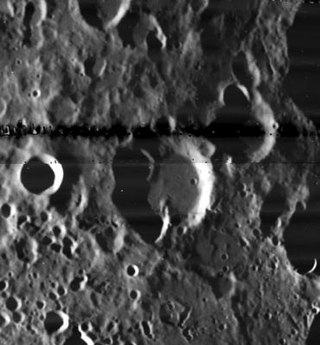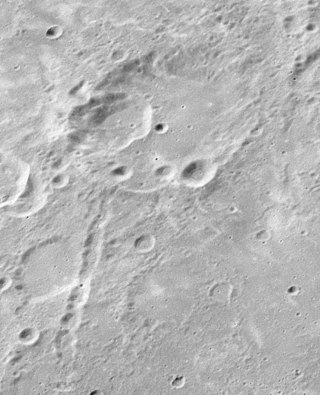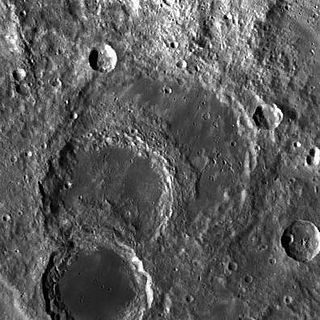
Agatharchides is a lunar impact crater located at the southern edge of Oceanus Procellarum, in the region between the Mare Humorum and Mare Nubium. To the east-southeast is the crater Bullialdus, and to the south-southwest lies Loewy. It is named after the Greek geographer Agatharchides.

Doppler is a lunar impact crater named for Christian Doppler that is located at the southern edge of the walled plain Korolev, on the far side of the Moon. To the east are the craters Das and Galois. Farther to the southwest of Doppler is Mohorovičić.

Artemʹev is a lunar impact crater that is located on the far side of the Moon. The rim of this crater has been modified by subsequent impacts in the vicinity, with an inward bulge along the southwest edge and a worn impact lying across the north rim. The satellite crater Artemʹev G is partly overlain by the southeast rim of Artemʹev. The crater interior is relatively flat, and marked only by tiny craterlets.

Fizeau is a prominent lunar impact crater that is located on the far side of the Moon, in the southern hemisphere. Nearby craters of note include Minkowski to the west-northwest, and Eijkman to the southwest.

Büsching is a lunar impact crater that is located in the crater-covered southern highlands of the Moon. It was named after German geographer Anton F. Büsching. The similar-sized crater Buch is located adjacent to its southwestern rim, and further to the southwest lies Maurolycus.

Pingré is a lunar impact crater that is located near the southwest limb of the Moon, beyond the large crater Phocylides. It lies to the northwest of the huge walled basin Bailly, and to the east of the smaller Graff. Due to its location, this crater appears foreshortened when viewed from the Earth.

Miller is a lunar impact crater that lies amidst the rugged terrain in the southern part of the Moon. It is attached to the northern rim of the smaller crater Nasireddin, and the outer rampart of the latter reaches almost to the central peak formation at the midpoint of Miller's interior floor. Together with Huggins to the southwest and Orontius to the south-southwest, this foursome forms a chain of craters forming an arc that curves towards the north. The northwest rim of Miller in turn is attached to the satellite crater Miller C, forming the end of the arc. To the southeast lies Stöfler. The crater is named after British chemist William Allen Miller.

Cook is a lunar impact crater that lies in the western part of the Mare Fecunditatis, just to the southeast of the prominent crater Colombo. To the southwest is Monge.

Clairaut is a lunar impact crater that is located in the rugged southern highlands of the Moon's near side. It lies directly to the south of the crater Maurolycus and southeast of Barocius. Just to the southwest is Cuvier.

Campbell is a large lunar impact crater that is located in the northern hemisphere on the far side of the Moon. It lies to the southwest of the walled plain D'Alembert, an even larger formation. If Campbell were located on the near side of the Moon as seen from the Earth, it would form one of the largest visible craters, being slightly larger than Schickard. It is bordered by several craters of note, with Wiener to the southwest, Von Neumann just to the south, Ley overlying the southeast rim, and Pawsey to the west.

Charlier is a lunar impact crater that is located on the far side of the Moon. To the south-southeast is the larger crater Kovalevskaya, and northeast of Charlier is Perrine.

Comstock is a lunar impact crater that is located on the far side of the Moon. It lies to the northeast of the walled plain Fersman, and north of the crater Weyl.

Douglass is a lunar impact crater on the far side of the Moon. It lies to the southwest of the crater Frost and south-southwest of the large walled plain Landau.

Dziewulski is a lunar impact crater on the far side of the Moon. It lies between the craters Edison to the north and Popov to the south. The outer rim of this crater has been considerably worn by impacts, particularly along the southwest quadrant where the satellite crater Dziewulski Q overlies the rim and the interior floor. The northern rim is also heavily disrupted, and several small crater lie along the southeast rim. The interior floor and surrounding terrain has been resurfaced.

Dante is a lunar impact crater that is located on the far side of the Moon. It lies in the northern hemisphere exactly opposite the prime meridian facing the Earth. The nearest craters of note are Larmor to the north and Morse to the southeast. To the southwest is the oddly shaped Buys-Ballot.
Eijkman is a lunar impact crater that is located on the far side of the Moon's southern hemisphere. It lies about a half crater diameter to the southeast of the larger crater Lemaître. To the south-southwest is the crater Crommelin, and to the northeast is Fizeau.

Erro is a lunar impact crater that lies beyond the eastern limb of the Moon, on the far side as seen from the Earth. It lies along the eastern fringes of the uneven plain that joins Mare Marginis to the northwest with Mare Smythii to the west-southwest. This part of the surface is sometimes brought into sight of observers on the Earth due to libration. However even at such times not much detail can be seen, as the surface is viewed from the edge.

Fersman is a large lunar impact crater on the Moon's far side. It lies to the east of the crater Poynting, and west-northwest of Weyl. To the south is the huge walled plain Hertzsprung.
Foster is a small lunar impact crater that lies to the southeast of the larger crater Joule, on the far side of the Moon. The rim of Foster is slightly eroded, and the narrow inner walls slope directly down to the relatively dark interior floor. The rim has a small outward bulge along the southwest side. There is a small craterlet on the floor next to the northern rim. A tiny impact in the southeast part of the crater interior is surrounded by a small skirt of high albedo material, producing a bright patch.

Richardson is a large lunar impact crater located on the Moon's far side, just behind the eastern limb. It lies to the south of the huge walled plain Harkhebi, and to the east-southeast of the crater Vestine. Just to the northeast is Szilard, and to the southeast is Artamonov.





















